Business Strategy for Sainsbury: PESTLE, SWOT, Ansoff's Matrix, Porter's Five Forces
VerifiedAdded on 2023/06/08
|13
|4548
|286
AI Summary
This report analyzes the internal and external factors affecting Sainsbury's business strategy, including PESTLE, SWOT, Ansoff's Matrix, and Porter's Five Forces analysis. It also provides valid tactics and objectives to achieve overall strategic objectives.
Contribute Materials
Your contribution can guide someone’s learning journey. Share your
documents today.
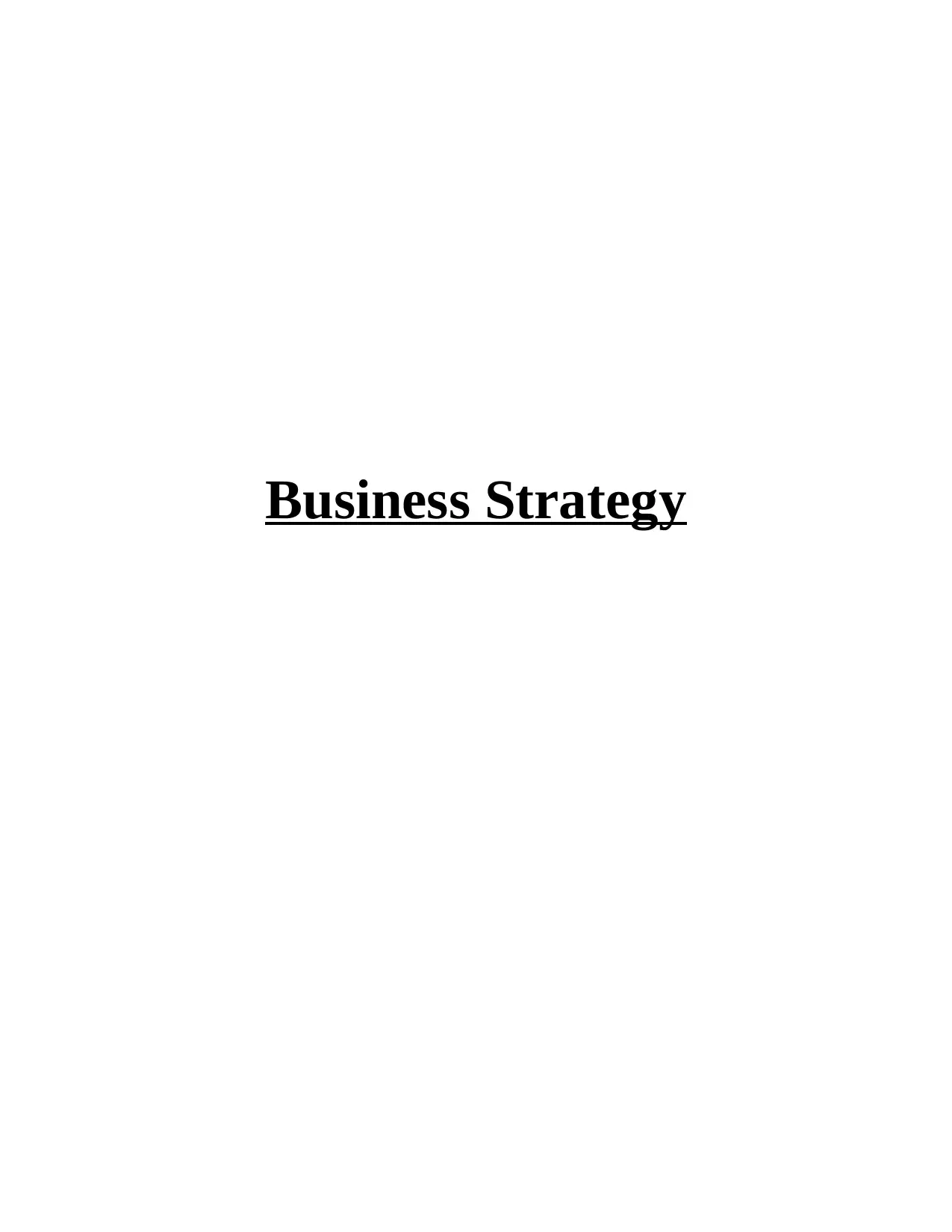
Business Strategy
Secure Best Marks with AI Grader
Need help grading? Try our AI Grader for instant feedback on your assignments.
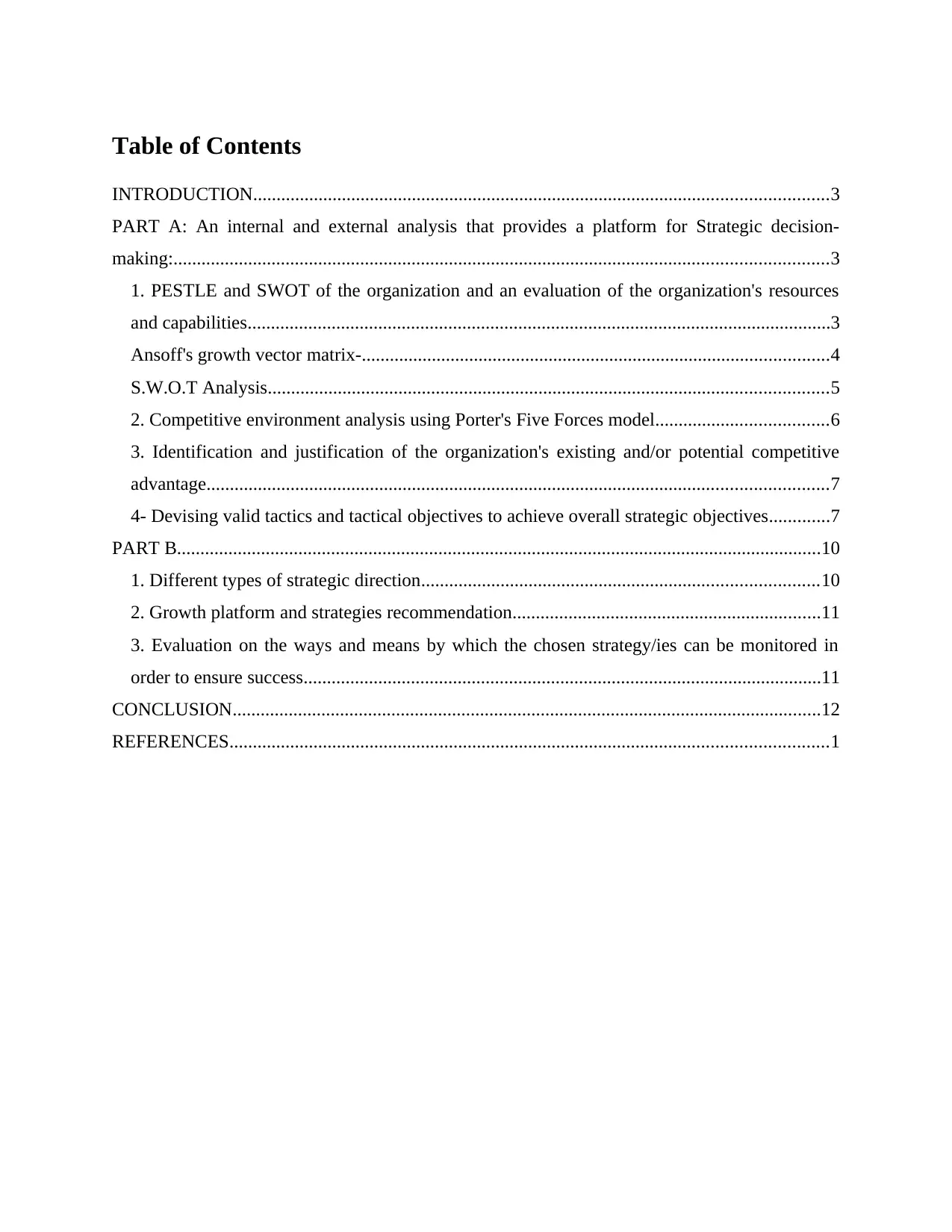
Table of Contents
INTRODUCTION...........................................................................................................................3
PART A: An internal and external analysis that provides a platform for Strategic decision-
making:............................................................................................................................................3
1. PESTLE and SWOT of the organization and an evaluation of the organization's resources
and capabilities.............................................................................................................................3
Ansoff's growth vector matrix-....................................................................................................4
S.W.O.T Analysis........................................................................................................................5
2. Competitive environment analysis using Porter's Five Forces model.....................................6
3. Identification and justification of the organization's existing and/or potential competitive
advantage.....................................................................................................................................7
4- Devising valid tactics and tactical objectives to achieve overall strategic objectives.............7
PART B..........................................................................................................................................10
1. Different types of strategic direction.....................................................................................10
2. Growth platform and strategies recommendation..................................................................11
3. Evaluation on the ways and means by which the chosen strategy/ies can be monitored in
order to ensure success...............................................................................................................11
CONCLUSION..............................................................................................................................12
REFERENCES................................................................................................................................1
INTRODUCTION...........................................................................................................................3
PART A: An internal and external analysis that provides a platform for Strategic decision-
making:............................................................................................................................................3
1. PESTLE and SWOT of the organization and an evaluation of the organization's resources
and capabilities.............................................................................................................................3
Ansoff's growth vector matrix-....................................................................................................4
S.W.O.T Analysis........................................................................................................................5
2. Competitive environment analysis using Porter's Five Forces model.....................................6
3. Identification and justification of the organization's existing and/or potential competitive
advantage.....................................................................................................................................7
4- Devising valid tactics and tactical objectives to achieve overall strategic objectives.............7
PART B..........................................................................................................................................10
1. Different types of strategic direction.....................................................................................10
2. Growth platform and strategies recommendation..................................................................11
3. Evaluation on the ways and means by which the chosen strategy/ies can be monitored in
order to ensure success...............................................................................................................11
CONCLUSION..............................................................................................................................12
REFERENCES................................................................................................................................1
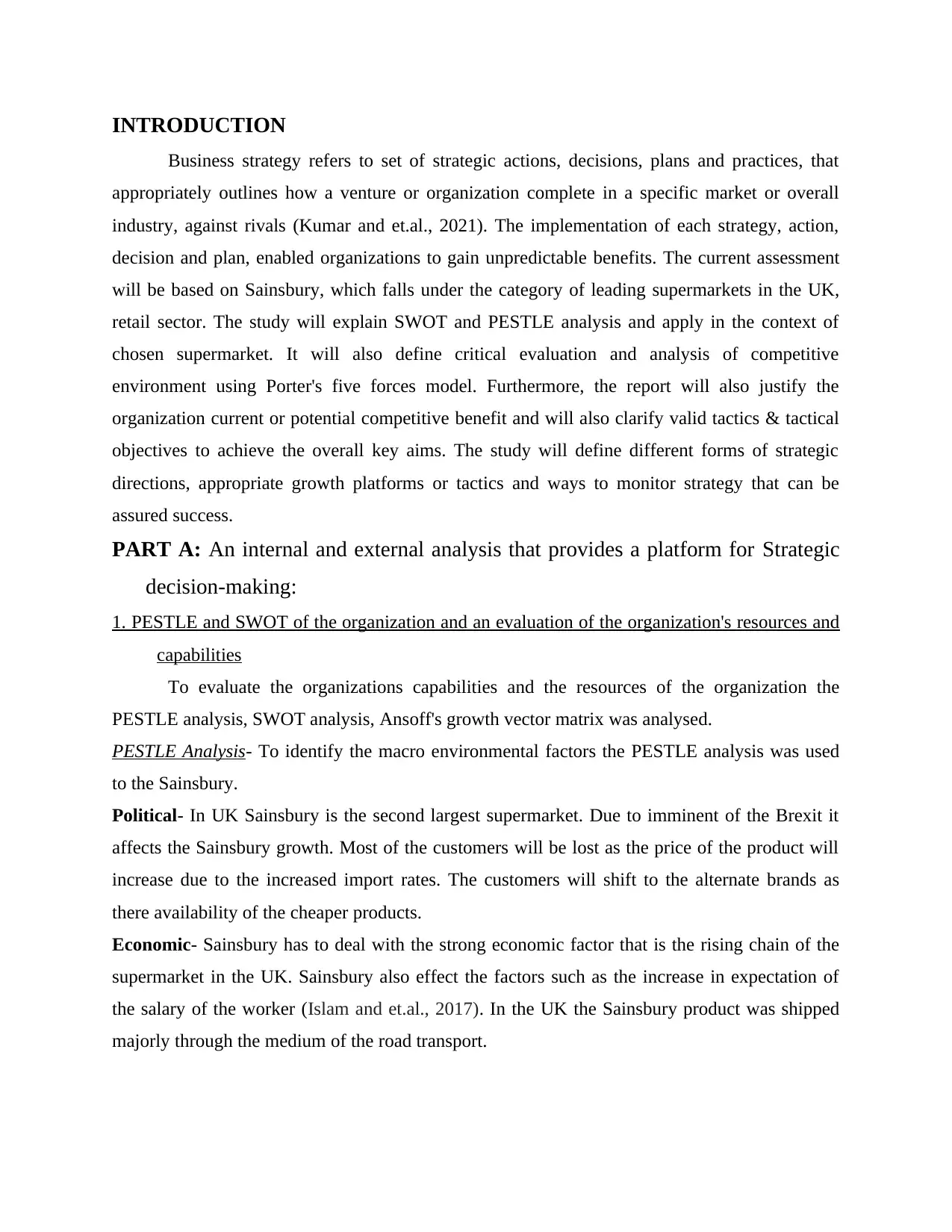
INTRODUCTION
Business strategy refers to set of strategic actions, decisions, plans and practices, that
appropriately outlines how a venture or organization complete in a specific market or overall
industry, against rivals (Kumar and et.al., 2021). The implementation of each strategy, action,
decision and plan, enabled organizations to gain unpredictable benefits. The current assessment
will be based on Sainsbury, which falls under the category of leading supermarkets in the UK,
retail sector. The study will explain SWOT and PESTLE analysis and apply in the context of
chosen supermarket. It will also define critical evaluation and analysis of competitive
environment using Porter's five forces model. Furthermore, the report will also justify the
organization current or potential competitive benefit and will also clarify valid tactics & tactical
objectives to achieve the overall key aims. The study will define different forms of strategic
directions, appropriate growth platforms or tactics and ways to monitor strategy that can be
assured success.
PART A: An internal and external analysis that provides a platform for Strategic
decision-making:
1. PESTLE and SWOT of the organization and an evaluation of the organization's resources and
capabilities
To evaluate the organizations capabilities and the resources of the organization the
PESTLE analysis, SWOT analysis, Ansoff's growth vector matrix was analysed.
PESTLE Analysis- To identify the macro environmental factors the PESTLE analysis was used
to the Sainsbury.
Political- In UK Sainsbury is the second largest supermarket. Due to imminent of the Brexit it
affects the Sainsbury growth. Most of the customers will be lost as the price of the product will
increase due to the increased import rates. The customers will shift to the alternate brands as
there availability of the cheaper products.
Economic- Sainsbury has to deal with the strong economic factor that is the rising chain of the
supermarket in the UK. Sainsbury also effect the factors such as the increase in expectation of
the salary of the worker (Islam and et.al., 2017). In the UK the Sainsbury product was shipped
majorly through the medium of the road transport.
Business strategy refers to set of strategic actions, decisions, plans and practices, that
appropriately outlines how a venture or organization complete in a specific market or overall
industry, against rivals (Kumar and et.al., 2021). The implementation of each strategy, action,
decision and plan, enabled organizations to gain unpredictable benefits. The current assessment
will be based on Sainsbury, which falls under the category of leading supermarkets in the UK,
retail sector. The study will explain SWOT and PESTLE analysis and apply in the context of
chosen supermarket. It will also define critical evaluation and analysis of competitive
environment using Porter's five forces model. Furthermore, the report will also justify the
organization current or potential competitive benefit and will also clarify valid tactics & tactical
objectives to achieve the overall key aims. The study will define different forms of strategic
directions, appropriate growth platforms or tactics and ways to monitor strategy that can be
assured success.
PART A: An internal and external analysis that provides a platform for Strategic
decision-making:
1. PESTLE and SWOT of the organization and an evaluation of the organization's resources and
capabilities
To evaluate the organizations capabilities and the resources of the organization the
PESTLE analysis, SWOT analysis, Ansoff's growth vector matrix was analysed.
PESTLE Analysis- To identify the macro environmental factors the PESTLE analysis was used
to the Sainsbury.
Political- In UK Sainsbury is the second largest supermarket. Due to imminent of the Brexit it
affects the Sainsbury growth. Most of the customers will be lost as the price of the product will
increase due to the increased import rates. The customers will shift to the alternate brands as
there availability of the cheaper products.
Economic- Sainsbury has to deal with the strong economic factor that is the rising chain of the
supermarket in the UK. Sainsbury also effect the factors such as the increase in expectation of
the salary of the worker (Islam and et.al., 2017). In the UK the Sainsbury product was shipped
majorly through the medium of the road transport.
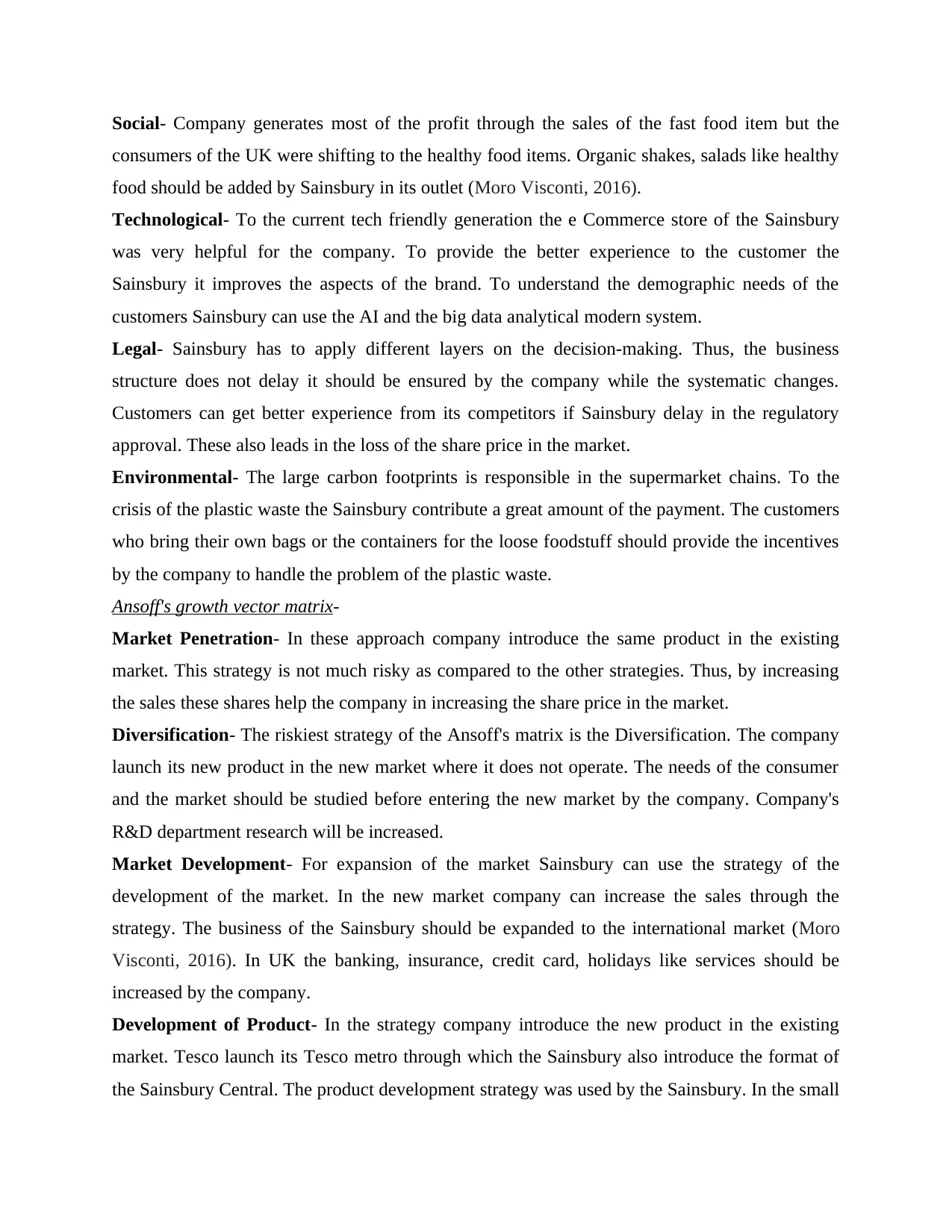
Social- Company generates most of the profit through the sales of the fast food item but the
consumers of the UK were shifting to the healthy food items. Organic shakes, salads like healthy
food should be added by Sainsbury in its outlet (Moro Visconti, 2016).
Technological- To the current tech friendly generation the e Commerce store of the Sainsbury
was very helpful for the company. To provide the better experience to the customer the
Sainsbury it improves the aspects of the brand. To understand the demographic needs of the
customers Sainsbury can use the AI and the big data analytical modern system.
Legal- Sainsbury has to apply different layers on the decision-making. Thus, the business
structure does not delay it should be ensured by the company while the systematic changes.
Customers can get better experience from its competitors if Sainsbury delay in the regulatory
approval. These also leads in the loss of the share price in the market.
Environmental- The large carbon footprints is responsible in the supermarket chains. To the
crisis of the plastic waste the Sainsbury contribute a great amount of the payment. The customers
who bring their own bags or the containers for the loose foodstuff should provide the incentives
by the company to handle the problem of the plastic waste.
Ansoff's growth vector matrix-
Market Penetration- In these approach company introduce the same product in the existing
market. This strategy is not much risky as compared to the other strategies. Thus, by increasing
the sales these shares help the company in increasing the share price in the market.
Diversification- The riskiest strategy of the Ansoff's matrix is the Diversification. The company
launch its new product in the new market where it does not operate. The needs of the consumer
and the market should be studied before entering the new market by the company. Company's
R&D department research will be increased.
Market Development- For expansion of the market Sainsbury can use the strategy of the
development of the market. In the new market company can increase the sales through the
strategy. The business of the Sainsbury should be expanded to the international market (Moro
Visconti, 2016). In UK the banking, insurance, credit card, holidays like services should be
increased by the company.
Development of Product- In the strategy company introduce the new product in the existing
market. Tesco launch its Tesco metro through which the Sainsbury also introduce the format of
the Sainsbury Central. The product development strategy was used by the Sainsbury. In the small
consumers of the UK were shifting to the healthy food items. Organic shakes, salads like healthy
food should be added by Sainsbury in its outlet (Moro Visconti, 2016).
Technological- To the current tech friendly generation the e Commerce store of the Sainsbury
was very helpful for the company. To provide the better experience to the customer the
Sainsbury it improves the aspects of the brand. To understand the demographic needs of the
customers Sainsbury can use the AI and the big data analytical modern system.
Legal- Sainsbury has to apply different layers on the decision-making. Thus, the business
structure does not delay it should be ensured by the company while the systematic changes.
Customers can get better experience from its competitors if Sainsbury delay in the regulatory
approval. These also leads in the loss of the share price in the market.
Environmental- The large carbon footprints is responsible in the supermarket chains. To the
crisis of the plastic waste the Sainsbury contribute a great amount of the payment. The customers
who bring their own bags or the containers for the loose foodstuff should provide the incentives
by the company to handle the problem of the plastic waste.
Ansoff's growth vector matrix-
Market Penetration- In these approach company introduce the same product in the existing
market. This strategy is not much risky as compared to the other strategies. Thus, by increasing
the sales these shares help the company in increasing the share price in the market.
Diversification- The riskiest strategy of the Ansoff's matrix is the Diversification. The company
launch its new product in the new market where it does not operate. The needs of the consumer
and the market should be studied before entering the new market by the company. Company's
R&D department research will be increased.
Market Development- For expansion of the market Sainsbury can use the strategy of the
development of the market. In the new market company can increase the sales through the
strategy. The business of the Sainsbury should be expanded to the international market (Moro
Visconti, 2016). In UK the banking, insurance, credit card, holidays like services should be
increased by the company.
Development of Product- In the strategy company introduce the new product in the existing
market. Tesco launch its Tesco metro through which the Sainsbury also introduce the format of
the Sainsbury Central. The product development strategy was used by the Sainsbury. In the small
Secure Best Marks with AI Grader
Need help grading? Try our AI Grader for instant feedback on your assignments.
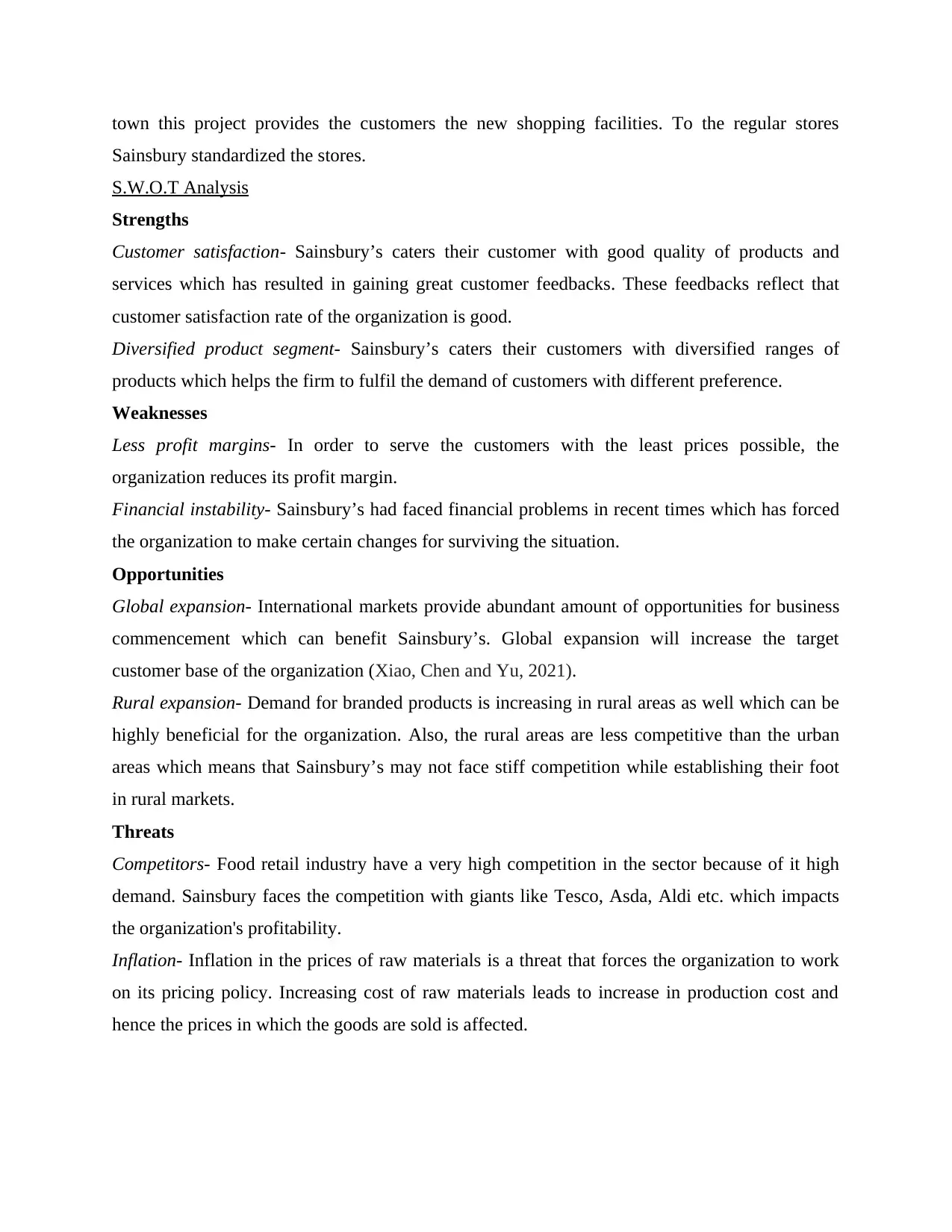
town this project provides the customers the new shopping facilities. To the regular stores
Sainsbury standardized the stores.
S.W.O.T Analysis
Strengths
Customer satisfaction- Sainsbury’s caters their customer with good quality of products and
services which has resulted in gaining great customer feedbacks. These feedbacks reflect that
customer satisfaction rate of the organization is good.
Diversified product segment- Sainsbury’s caters their customers with diversified ranges of
products which helps the firm to fulfil the demand of customers with different preference.
Weaknesses
Less profit margins- In order to serve the customers with the least prices possible, the
organization reduces its profit margin.
Financial instability- Sainsbury’s had faced financial problems in recent times which has forced
the organization to make certain changes for surviving the situation.
Opportunities
Global expansion- International markets provide abundant amount of opportunities for business
commencement which can benefit Sainsbury’s. Global expansion will increase the target
customer base of the organization (Xiao, Chen and Yu, 2021).
Rural expansion- Demand for branded products is increasing in rural areas as well which can be
highly beneficial for the organization. Also, the rural areas are less competitive than the urban
areas which means that Sainsbury’s may not face stiff competition while establishing their foot
in rural markets.
Threats
Competitors- Food retail industry have a very high competition in the sector because of it high
demand. Sainsbury faces the competition with giants like Tesco, Asda, Aldi etc. which impacts
the organization's profitability.
Inflation- Inflation in the prices of raw materials is a threat that forces the organization to work
on its pricing policy. Increasing cost of raw materials leads to increase in production cost and
hence the prices in which the goods are sold is affected.
Sainsbury standardized the stores.
S.W.O.T Analysis
Strengths
Customer satisfaction- Sainsbury’s caters their customer with good quality of products and
services which has resulted in gaining great customer feedbacks. These feedbacks reflect that
customer satisfaction rate of the organization is good.
Diversified product segment- Sainsbury’s caters their customers with diversified ranges of
products which helps the firm to fulfil the demand of customers with different preference.
Weaknesses
Less profit margins- In order to serve the customers with the least prices possible, the
organization reduces its profit margin.
Financial instability- Sainsbury’s had faced financial problems in recent times which has forced
the organization to make certain changes for surviving the situation.
Opportunities
Global expansion- International markets provide abundant amount of opportunities for business
commencement which can benefit Sainsbury’s. Global expansion will increase the target
customer base of the organization (Xiao, Chen and Yu, 2021).
Rural expansion- Demand for branded products is increasing in rural areas as well which can be
highly beneficial for the organization. Also, the rural areas are less competitive than the urban
areas which means that Sainsbury’s may not face stiff competition while establishing their foot
in rural markets.
Threats
Competitors- Food retail industry have a very high competition in the sector because of it high
demand. Sainsbury faces the competition with giants like Tesco, Asda, Aldi etc. which impacts
the organization's profitability.
Inflation- Inflation in the prices of raw materials is a threat that forces the organization to work
on its pricing policy. Increasing cost of raw materials leads to increase in production cost and
hence the prices in which the goods are sold is affected.
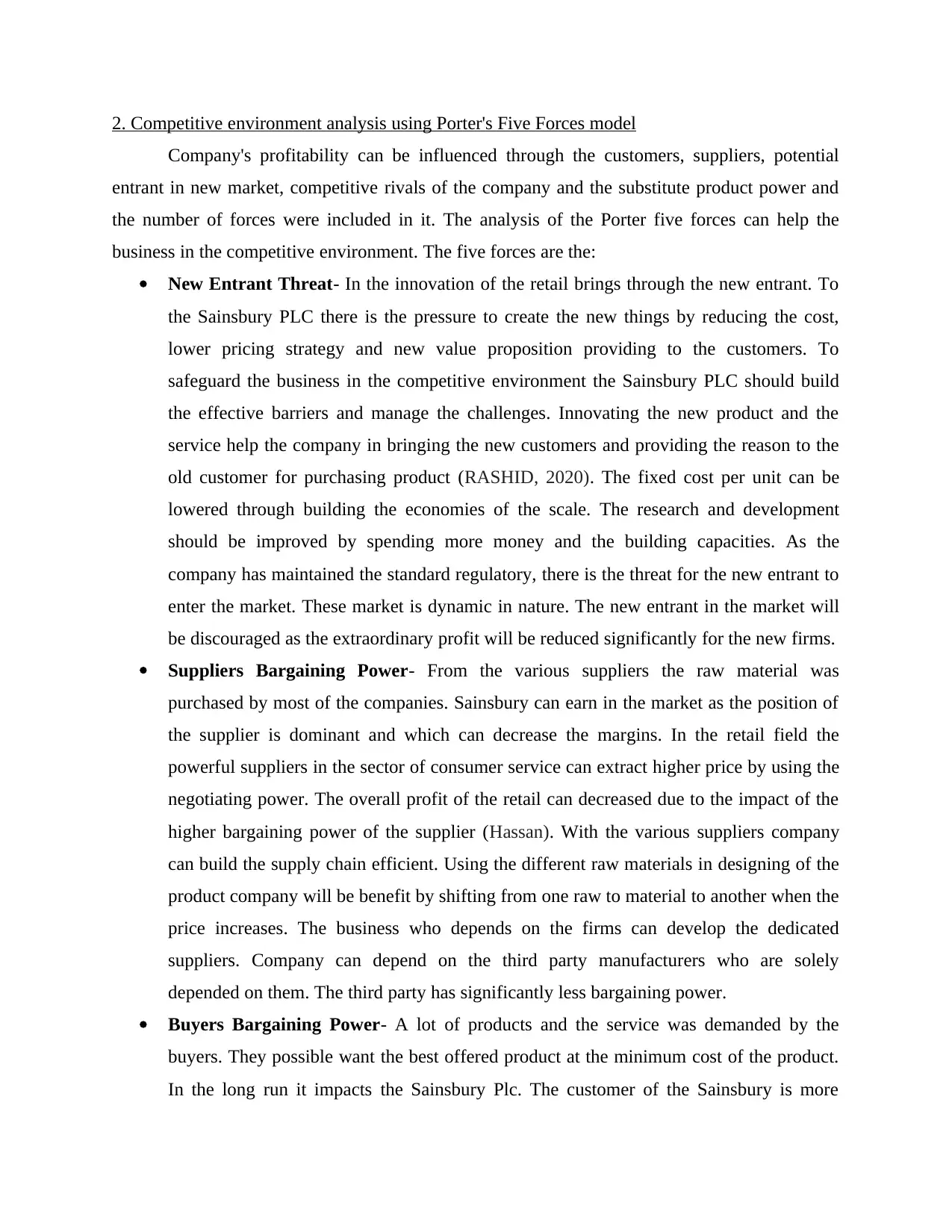
2. Competitive environment analysis using Porter's Five Forces model
Company's profitability can be influenced through the customers, suppliers, potential
entrant in new market, competitive rivals of the company and the substitute product power and
the number of forces were included in it. The analysis of the Porter five forces can help the
business in the competitive environment. The five forces are the:
New Entrant Threat- In the innovation of the retail brings through the new entrant. To
the Sainsbury PLC there is the pressure to create the new things by reducing the cost,
lower pricing strategy and new value proposition providing to the customers. To
safeguard the business in the competitive environment the Sainsbury PLC should build
the effective barriers and manage the challenges. Innovating the new product and the
service help the company in bringing the new customers and providing the reason to the
old customer for purchasing product (RASHID, 2020). The fixed cost per unit can be
lowered through building the economies of the scale. The research and development
should be improved by spending more money and the building capacities. As the
company has maintained the standard regulatory, there is the threat for the new entrant to
enter the market. These market is dynamic in nature. The new entrant in the market will
be discouraged as the extraordinary profit will be reduced significantly for the new firms.
Suppliers Bargaining Power- From the various suppliers the raw material was
purchased by most of the companies. Sainsbury can earn in the market as the position of
the supplier is dominant and which can decrease the margins. In the retail field the
powerful suppliers in the sector of consumer service can extract higher price by using the
negotiating power. The overall profit of the retail can decreased due to the impact of the
higher bargaining power of the supplier (Hassan). With the various suppliers company
can build the supply chain efficient. Using the different raw materials in designing of the
product company will be benefit by shifting from one raw to material to another when the
price increases. The business who depends on the firms can develop the dedicated
suppliers. Company can depend on the third party manufacturers who are solely
depended on them. The third party has significantly less bargaining power.
Buyers Bargaining Power- A lot of products and the service was demanded by the
buyers. They possible want the best offered product at the minimum cost of the product.
In the long run it impacts the Sainsbury Plc. The customer of the Sainsbury is more
Company's profitability can be influenced through the customers, suppliers, potential
entrant in new market, competitive rivals of the company and the substitute product power and
the number of forces were included in it. The analysis of the Porter five forces can help the
business in the competitive environment. The five forces are the:
New Entrant Threat- In the innovation of the retail brings through the new entrant. To
the Sainsbury PLC there is the pressure to create the new things by reducing the cost,
lower pricing strategy and new value proposition providing to the customers. To
safeguard the business in the competitive environment the Sainsbury PLC should build
the effective barriers and manage the challenges. Innovating the new product and the
service help the company in bringing the new customers and providing the reason to the
old customer for purchasing product (RASHID, 2020). The fixed cost per unit can be
lowered through building the economies of the scale. The research and development
should be improved by spending more money and the building capacities. As the
company has maintained the standard regulatory, there is the threat for the new entrant to
enter the market. These market is dynamic in nature. The new entrant in the market will
be discouraged as the extraordinary profit will be reduced significantly for the new firms.
Suppliers Bargaining Power- From the various suppliers the raw material was
purchased by most of the companies. Sainsbury can earn in the market as the position of
the supplier is dominant and which can decrease the margins. In the retail field the
powerful suppliers in the sector of consumer service can extract higher price by using the
negotiating power. The overall profit of the retail can decreased due to the impact of the
higher bargaining power of the supplier (Hassan). With the various suppliers company
can build the supply chain efficient. Using the different raw materials in designing of the
product company will be benefit by shifting from one raw to material to another when the
price increases. The business who depends on the firms can develop the dedicated
suppliers. Company can depend on the third party manufacturers who are solely
depended on them. The third party has significantly less bargaining power.
Buyers Bargaining Power- A lot of products and the service was demanded by the
buyers. They possible want the best offered product at the minimum cost of the product.
In the long run it impacts the Sainsbury Plc. The customer of the Sainsbury is more

powerful and small. The bargaining power of the customer is higher and the ability to sell
the offers and the discounts is increasing and higher.
Substitute Products Threat- Industry suffers in the profit when the new product or the
services compile with the similar type of needs of the customers (Sainsbury, 2020).
Example, the Google drive and the Dropbox is providing the hardware drive storage
substitutes. If the offered proposition value is different from the current industry offerings
then there is a high threat of substitute product and the services. Company should be both
the product and the service oriented. Customers switching should be increased. Sainsbury
should not focus on buying of customer it should more focus on the need of the customer.
Existing Players Rivalry- Industry profit can be decreased and the price of the product
also decreased if the existing company in the market is intense. In the retail industry
Sainsbury operates in very competitive environment. The organization long term profit
can impact due to the competition. Sustainable differentiation should be build up and to
better compete there should be build up of scale. The company should not just compete
with small market. To increase the size of the market it should collaborate with the
competitors.
3. Identification and justification of the organization's existing and/or potential competitive
advantage
Over the competitors of the Sainsbury Fair-trade gives a competitive advantage in the
ethical way to trade. In the supermarket fair trade conference it was said that there was believed
in the fair-trade to the stake of the fair-trade. It requires the both supply chain and the product in
the fair-trade for working in the new way. The cost has to be bear by the retailers or the
consumers. In the supply system it makes sure of removing the unnecessary cost. Consumers
were not attracted through the prize in the fair-trade (Hana, 2013). In 2007 putting the stamp on
the bananas the Sainsbury manage the communication of the consumers with the message of the
fair-trade. Doing the good market research Sainsbury satisfy its customers. Company provides
the high standard product to the consumers by keeping the low cost price of the product.
4- Devising valid tactics and tactical objectives to achieve overall strategic objectives
Sainsbury may not have competitive market size, as it established its venture within some
nations, which is not suitable for its rapid and competitive growth in the retail industry. It is
the offers and the discounts is increasing and higher.
Substitute Products Threat- Industry suffers in the profit when the new product or the
services compile with the similar type of needs of the customers (Sainsbury, 2020).
Example, the Google drive and the Dropbox is providing the hardware drive storage
substitutes. If the offered proposition value is different from the current industry offerings
then there is a high threat of substitute product and the services. Company should be both
the product and the service oriented. Customers switching should be increased. Sainsbury
should not focus on buying of customer it should more focus on the need of the customer.
Existing Players Rivalry- Industry profit can be decreased and the price of the product
also decreased if the existing company in the market is intense. In the retail industry
Sainsbury operates in very competitive environment. The organization long term profit
can impact due to the competition. Sustainable differentiation should be build up and to
better compete there should be build up of scale. The company should not just compete
with small market. To increase the size of the market it should collaborate with the
competitors.
3. Identification and justification of the organization's existing and/or potential competitive
advantage
Over the competitors of the Sainsbury Fair-trade gives a competitive advantage in the
ethical way to trade. In the supermarket fair trade conference it was said that there was believed
in the fair-trade to the stake of the fair-trade. It requires the both supply chain and the product in
the fair-trade for working in the new way. The cost has to be bear by the retailers or the
consumers. In the supply system it makes sure of removing the unnecessary cost. Consumers
were not attracted through the prize in the fair-trade (Hana, 2013). In 2007 putting the stamp on
the bananas the Sainsbury manage the communication of the consumers with the message of the
fair-trade. Doing the good market research Sainsbury satisfy its customers. Company provides
the high standard product to the consumers by keeping the low cost price of the product.
4- Devising valid tactics and tactical objectives to achieve overall strategic objectives
Sainsbury may not have competitive market size, as it established its venture within some
nations, which is not suitable for its rapid and competitive growth in the retail industry. It is
Paraphrase This Document
Need a fresh take? Get an instant paraphrase of this document with our AI Paraphraser
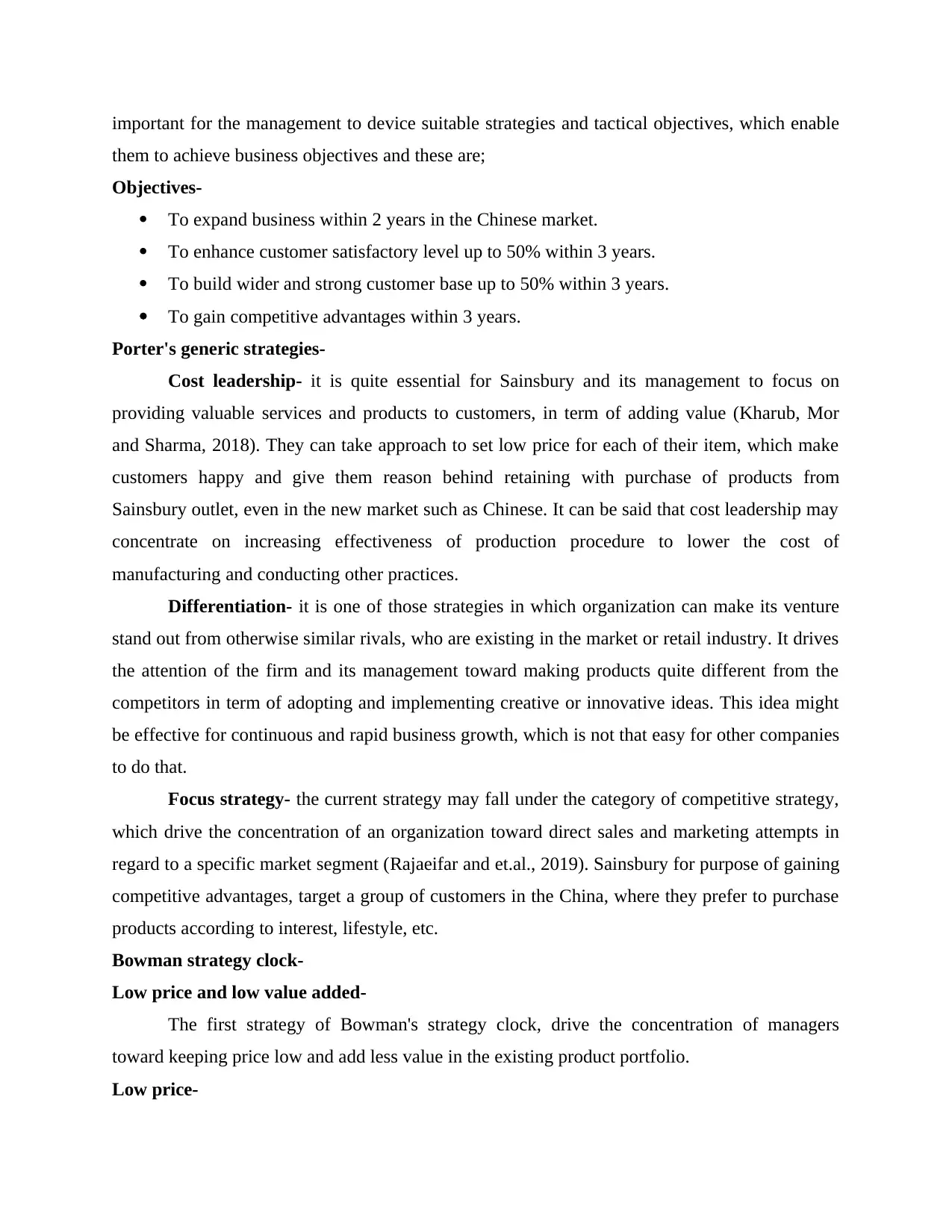
important for the management to device suitable strategies and tactical objectives, which enable
them to achieve business objectives and these are;
Objectives-
To expand business within 2 years in the Chinese market.
To enhance customer satisfactory level up to 50% within 3 years.
To build wider and strong customer base up to 50% within 3 years.
To gain competitive advantages within 3 years.
Porter's generic strategies-
Cost leadership- it is quite essential for Sainsbury and its management to focus on
providing valuable services and products to customers, in term of adding value (Kharub, Mor
and Sharma, 2018). They can take approach to set low price for each of their item, which make
customers happy and give them reason behind retaining with purchase of products from
Sainsbury outlet, even in the new market such as Chinese. It can be said that cost leadership may
concentrate on increasing effectiveness of production procedure to lower the cost of
manufacturing and conducting other practices.
Differentiation- it is one of those strategies in which organization can make its venture
stand out from otherwise similar rivals, who are existing in the market or retail industry. It drives
the attention of the firm and its management toward making products quite different from the
competitors in term of adopting and implementing creative or innovative ideas. This idea might
be effective for continuous and rapid business growth, which is not that easy for other companies
to do that.
Focus strategy- the current strategy may fall under the category of competitive strategy,
which drive the concentration of an organization toward direct sales and marketing attempts in
regard to a specific market segment (Rajaeifar and et.al., 2019). Sainsbury for purpose of gaining
competitive advantages, target a group of customers in the China, where they prefer to purchase
products according to interest, lifestyle, etc.
Bowman strategy clock-
Low price and low value added-
The first strategy of Bowman's strategy clock, drive the concentration of managers
toward keeping price low and add less value in the existing product portfolio.
Low price-
them to achieve business objectives and these are;
Objectives-
To expand business within 2 years in the Chinese market.
To enhance customer satisfactory level up to 50% within 3 years.
To build wider and strong customer base up to 50% within 3 years.
To gain competitive advantages within 3 years.
Porter's generic strategies-
Cost leadership- it is quite essential for Sainsbury and its management to focus on
providing valuable services and products to customers, in term of adding value (Kharub, Mor
and Sharma, 2018). They can take approach to set low price for each of their item, which make
customers happy and give them reason behind retaining with purchase of products from
Sainsbury outlet, even in the new market such as Chinese. It can be said that cost leadership may
concentrate on increasing effectiveness of production procedure to lower the cost of
manufacturing and conducting other practices.
Differentiation- it is one of those strategies in which organization can make its venture
stand out from otherwise similar rivals, who are existing in the market or retail industry. It drives
the attention of the firm and its management toward making products quite different from the
competitors in term of adopting and implementing creative or innovative ideas. This idea might
be effective for continuous and rapid business growth, which is not that easy for other companies
to do that.
Focus strategy- the current strategy may fall under the category of competitive strategy,
which drive the concentration of an organization toward direct sales and marketing attempts in
regard to a specific market segment (Rajaeifar and et.al., 2019). Sainsbury for purpose of gaining
competitive advantages, target a group of customers in the China, where they prefer to purchase
products according to interest, lifestyle, etc.
Bowman strategy clock-
Low price and low value added-
The first strategy of Bowman's strategy clock, drive the concentration of managers
toward keeping price low and add less value in the existing product portfolio.
Low price-
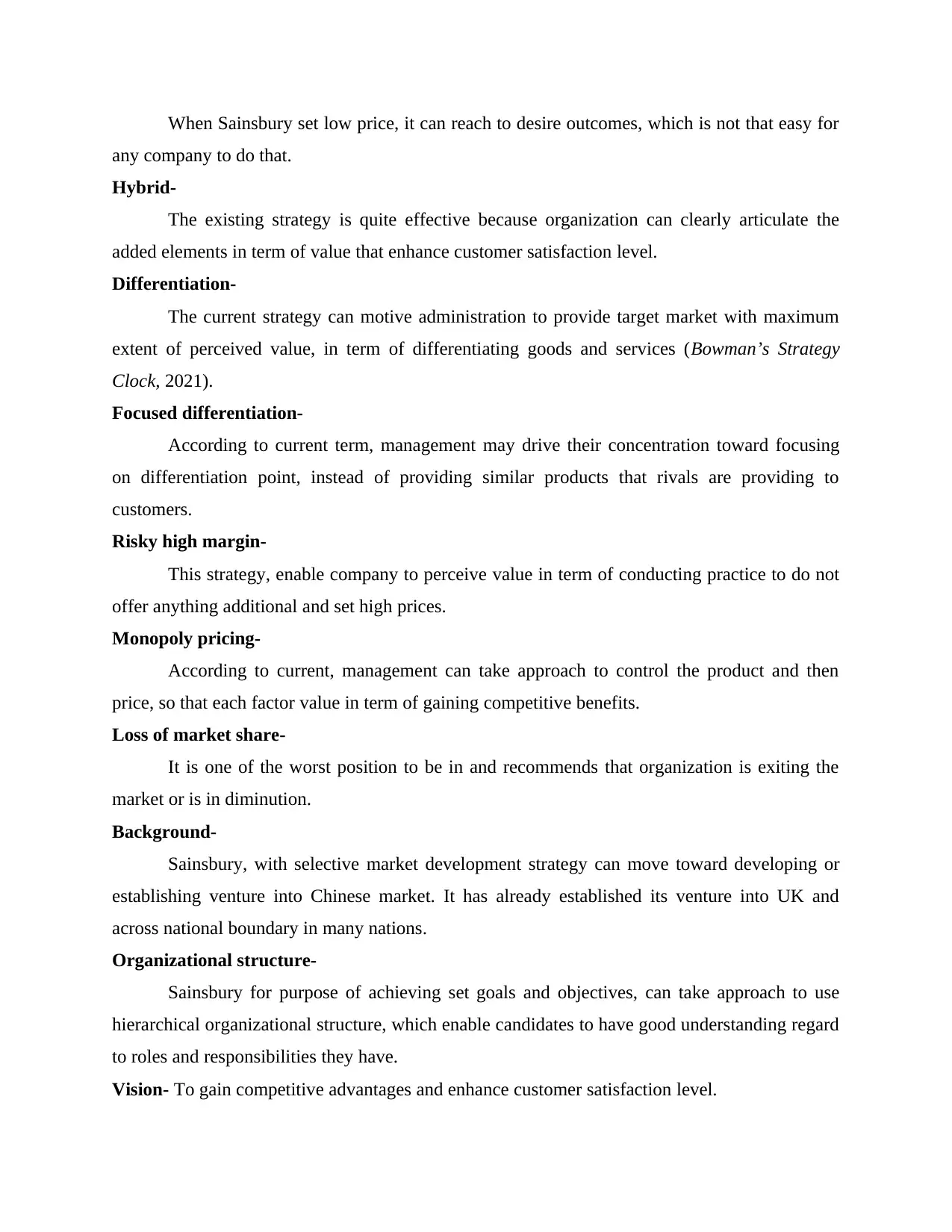
When Sainsbury set low price, it can reach to desire outcomes, which is not that easy for
any company to do that.
Hybrid-
The existing strategy is quite effective because organization can clearly articulate the
added elements in term of value that enhance customer satisfaction level.
Differentiation-
The current strategy can motive administration to provide target market with maximum
extent of perceived value, in term of differentiating goods and services (Bowman’s Strategy
Clock, 2021).
Focused differentiation-
According to current term, management may drive their concentration toward focusing
on differentiation point, instead of providing similar products that rivals are providing to
customers.
Risky high margin-
This strategy, enable company to perceive value in term of conducting practice to do not
offer anything additional and set high prices.
Monopoly pricing-
According to current, management can take approach to control the product and then
price, so that each factor value in term of gaining competitive benefits.
Loss of market share-
It is one of the worst position to be in and recommends that organization is exiting the
market or is in diminution.
Background-
Sainsbury, with selective market development strategy can move toward developing or
establishing venture into Chinese market. It has already established its venture into UK and
across national boundary in many nations.
Organizational structure-
Sainsbury for purpose of achieving set goals and objectives, can take approach to use
hierarchical organizational structure, which enable candidates to have good understanding regard
to roles and responsibilities they have.
Vision- To gain competitive advantages and enhance customer satisfaction level.
any company to do that.
Hybrid-
The existing strategy is quite effective because organization can clearly articulate the
added elements in term of value that enhance customer satisfaction level.
Differentiation-
The current strategy can motive administration to provide target market with maximum
extent of perceived value, in term of differentiating goods and services (Bowman’s Strategy
Clock, 2021).
Focused differentiation-
According to current term, management may drive their concentration toward focusing
on differentiation point, instead of providing similar products that rivals are providing to
customers.
Risky high margin-
This strategy, enable company to perceive value in term of conducting practice to do not
offer anything additional and set high prices.
Monopoly pricing-
According to current, management can take approach to control the product and then
price, so that each factor value in term of gaining competitive benefits.
Loss of market share-
It is one of the worst position to be in and recommends that organization is exiting the
market or is in diminution.
Background-
Sainsbury, with selective market development strategy can move toward developing or
establishing venture into Chinese market. It has already established its venture into UK and
across national boundary in many nations.
Organizational structure-
Sainsbury for purpose of achieving set goals and objectives, can take approach to use
hierarchical organizational structure, which enable candidates to have good understanding regard
to roles and responsibilities they have.
Vision- To gain competitive advantages and enhance customer satisfaction level.
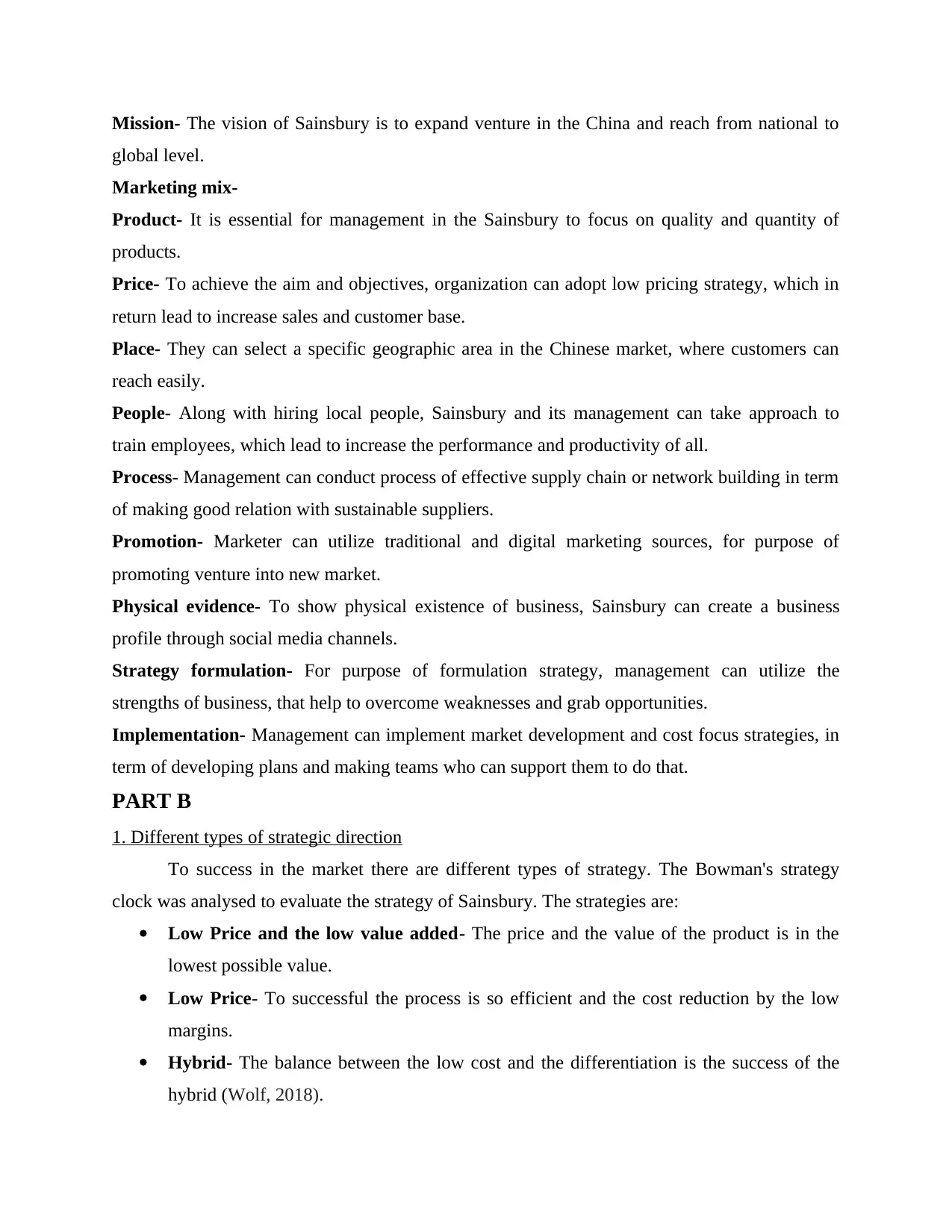
Mission- The vision of Sainsbury is to expand venture in the China and reach from national to
global level.
Marketing mix-
Product- It is essential for management in the Sainsbury to focus on quality and quantity of
products.
Price- To achieve the aim and objectives, organization can adopt low pricing strategy, which in
return lead to increase sales and customer base.
Place- They can select a specific geographic area in the Chinese market, where customers can
reach easily.
People- Along with hiring local people, Sainsbury and its management can take approach to
train employees, which lead to increase the performance and productivity of all.
Process- Management can conduct process of effective supply chain or network building in term
of making good relation with sustainable suppliers.
Promotion- Marketer can utilize traditional and digital marketing sources, for purpose of
promoting venture into new market.
Physical evidence- To show physical existence of business, Sainsbury can create a business
profile through social media channels.
Strategy formulation- For purpose of formulation strategy, management can utilize the
strengths of business, that help to overcome weaknesses and grab opportunities.
Implementation- Management can implement market development and cost focus strategies, in
term of developing plans and making teams who can support them to do that.
PART B
1. Different types of strategic direction
To success in the market there are different types of strategy. The Bowman's strategy
clock was analysed to evaluate the strategy of Sainsbury. The strategies are:
Low Price and the low value added- The price and the value of the product is in the
lowest possible value.
Low Price- To successful the process is so efficient and the cost reduction by the low
margins.
Hybrid- The balance between the low cost and the differentiation is the success of the
hybrid (Wolf, 2018).
global level.
Marketing mix-
Product- It is essential for management in the Sainsbury to focus on quality and quantity of
products.
Price- To achieve the aim and objectives, organization can adopt low pricing strategy, which in
return lead to increase sales and customer base.
Place- They can select a specific geographic area in the Chinese market, where customers can
reach easily.
People- Along with hiring local people, Sainsbury and its management can take approach to
train employees, which lead to increase the performance and productivity of all.
Process- Management can conduct process of effective supply chain or network building in term
of making good relation with sustainable suppliers.
Promotion- Marketer can utilize traditional and digital marketing sources, for purpose of
promoting venture into new market.
Physical evidence- To show physical existence of business, Sainsbury can create a business
profile through social media channels.
Strategy formulation- For purpose of formulation strategy, management can utilize the
strengths of business, that help to overcome weaknesses and grab opportunities.
Implementation- Management can implement market development and cost focus strategies, in
term of developing plans and making teams who can support them to do that.
PART B
1. Different types of strategic direction
To success in the market there are different types of strategy. The Bowman's strategy
clock was analysed to evaluate the strategy of Sainsbury. The strategies are:
Low Price and the low value added- The price and the value of the product is in the
lowest possible value.
Low Price- To successful the process is so efficient and the cost reduction by the low
margins.
Hybrid- The balance between the low cost and the differentiation is the success of the
hybrid (Wolf, 2018).
Secure Best Marks with AI Grader
Need help grading? Try our AI Grader for instant feedback on your assignments.
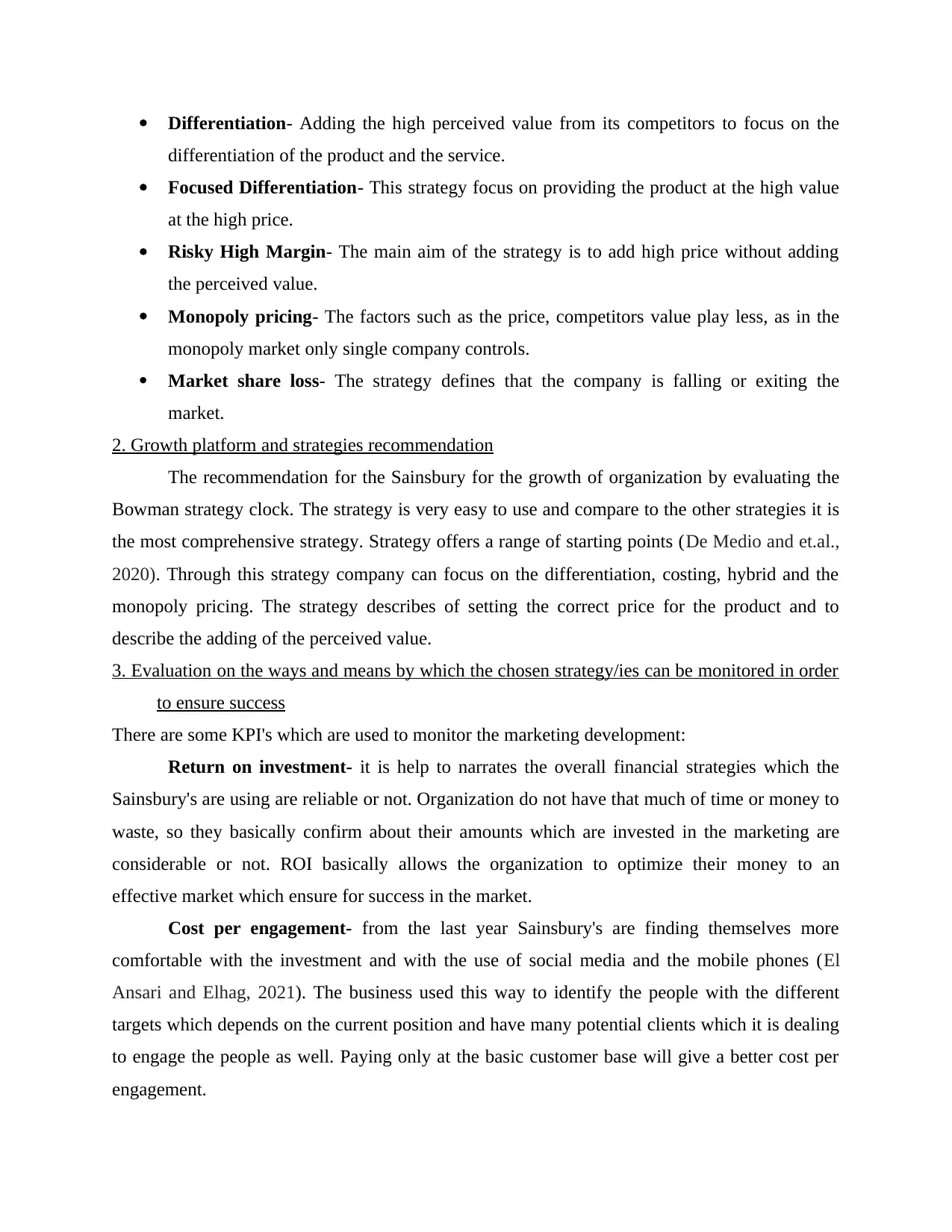
Differentiation- Adding the high perceived value from its competitors to focus on the
differentiation of the product and the service.
Focused Differentiation- This strategy focus on providing the product at the high value
at the high price.
Risky High Margin- The main aim of the strategy is to add high price without adding
the perceived value.
Monopoly pricing- The factors such as the price, competitors value play less, as in the
monopoly market only single company controls.
Market share loss- The strategy defines that the company is falling or exiting the
market.
2. Growth platform and strategies recommendation
The recommendation for the Sainsbury for the growth of organization by evaluating the
Bowman strategy clock. The strategy is very easy to use and compare to the other strategies it is
the most comprehensive strategy. Strategy offers a range of starting points (De Medio and et.al.,
2020). Through this strategy company can focus on the differentiation, costing, hybrid and the
monopoly pricing. The strategy describes of setting the correct price for the product and to
describe the adding of the perceived value.
3. Evaluation on the ways and means by which the chosen strategy/ies can be monitored in order
to ensure success
There are some KPI's which are used to monitor the marketing development:
Return on investment- it is help to narrates the overall financial strategies which the
Sainsbury's are using are reliable or not. Organization do not have that much of time or money to
waste, so they basically confirm about their amounts which are invested in the marketing are
considerable or not. ROI basically allows the organization to optimize their money to an
effective market which ensure for success in the market.
Cost per engagement- from the last year Sainsbury's are finding themselves more
comfortable with the investment and with the use of social media and the mobile phones (El
Ansari and Elhag, 2021). The business used this way to identify the people with the different
targets which depends on the current position and have many potential clients which it is dealing
to engage the people as well. Paying only at the basic customer base will give a better cost per
engagement.
differentiation of the product and the service.
Focused Differentiation- This strategy focus on providing the product at the high value
at the high price.
Risky High Margin- The main aim of the strategy is to add high price without adding
the perceived value.
Monopoly pricing- The factors such as the price, competitors value play less, as in the
monopoly market only single company controls.
Market share loss- The strategy defines that the company is falling or exiting the
market.
2. Growth platform and strategies recommendation
The recommendation for the Sainsbury for the growth of organization by evaluating the
Bowman strategy clock. The strategy is very easy to use and compare to the other strategies it is
the most comprehensive strategy. Strategy offers a range of starting points (De Medio and et.al.,
2020). Through this strategy company can focus on the differentiation, costing, hybrid and the
monopoly pricing. The strategy describes of setting the correct price for the product and to
describe the adding of the perceived value.
3. Evaluation on the ways and means by which the chosen strategy/ies can be monitored in order
to ensure success
There are some KPI's which are used to monitor the marketing development:
Return on investment- it is help to narrates the overall financial strategies which the
Sainsbury's are using are reliable or not. Organization do not have that much of time or money to
waste, so they basically confirm about their amounts which are invested in the marketing are
considerable or not. ROI basically allows the organization to optimize their money to an
effective market which ensure for success in the market.
Cost per engagement- from the last year Sainsbury's are finding themselves more
comfortable with the investment and with the use of social media and the mobile phones (El
Ansari and Elhag, 2021). The business used this way to identify the people with the different
targets which depends on the current position and have many potential clients which it is dealing
to engage the people as well. Paying only at the basic customer base will give a better cost per
engagement.
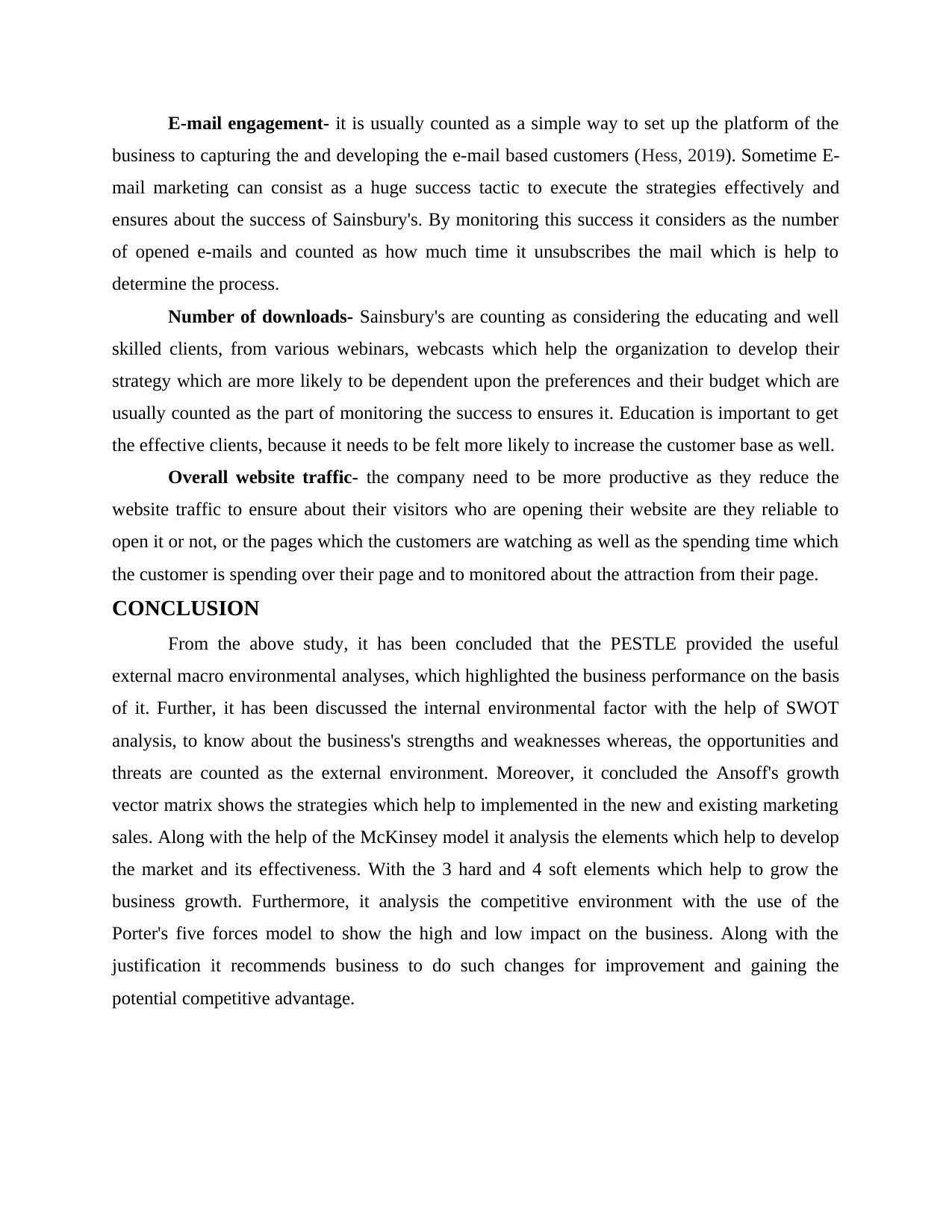
E-mail engagement- it is usually counted as a simple way to set up the platform of the
business to capturing the and developing the e-mail based customers (Hess, 2019). Sometime E-
mail marketing can consist as a huge success tactic to execute the strategies effectively and
ensures about the success of Sainsbury's. By monitoring this success it considers as the number
of opened e-mails and counted as how much time it unsubscribes the mail which is help to
determine the process.
Number of downloads- Sainsbury's are counting as considering the educating and well
skilled clients, from various webinars, webcasts which help the organization to develop their
strategy which are more likely to be dependent upon the preferences and their budget which are
usually counted as the part of monitoring the success to ensures it. Education is important to get
the effective clients, because it needs to be felt more likely to increase the customer base as well.
Overall website traffic- the company need to be more productive as they reduce the
website traffic to ensure about their visitors who are opening their website are they reliable to
open it or not, or the pages which the customers are watching as well as the spending time which
the customer is spending over their page and to monitored about the attraction from their page.
CONCLUSION
From the above study, it has been concluded that the PESTLE provided the useful
external macro environmental analyses, which highlighted the business performance on the basis
of it. Further, it has been discussed the internal environmental factor with the help of SWOT
analysis, to know about the business's strengths and weaknesses whereas, the opportunities and
threats are counted as the external environment. Moreover, it concluded the Ansoff's growth
vector matrix shows the strategies which help to implemented in the new and existing marketing
sales. Along with the help of the McKinsey model it analysis the elements which help to develop
the market and its effectiveness. With the 3 hard and 4 soft elements which help to grow the
business growth. Furthermore, it analysis the competitive environment with the use of the
Porter's five forces model to show the high and low impact on the business. Along with the
justification it recommends business to do such changes for improvement and gaining the
potential competitive advantage.
business to capturing the and developing the e-mail based customers (Hess, 2019). Sometime E-
mail marketing can consist as a huge success tactic to execute the strategies effectively and
ensures about the success of Sainsbury's. By monitoring this success it considers as the number
of opened e-mails and counted as how much time it unsubscribes the mail which is help to
determine the process.
Number of downloads- Sainsbury's are counting as considering the educating and well
skilled clients, from various webinars, webcasts which help the organization to develop their
strategy which are more likely to be dependent upon the preferences and their budget which are
usually counted as the part of monitoring the success to ensures it. Education is important to get
the effective clients, because it needs to be felt more likely to increase the customer base as well.
Overall website traffic- the company need to be more productive as they reduce the
website traffic to ensure about their visitors who are opening their website are they reliable to
open it or not, or the pages which the customers are watching as well as the spending time which
the customer is spending over their page and to monitored about the attraction from their page.
CONCLUSION
From the above study, it has been concluded that the PESTLE provided the useful
external macro environmental analyses, which highlighted the business performance on the basis
of it. Further, it has been discussed the internal environmental factor with the help of SWOT
analysis, to know about the business's strengths and weaknesses whereas, the opportunities and
threats are counted as the external environment. Moreover, it concluded the Ansoff's growth
vector matrix shows the strategies which help to implemented in the new and existing marketing
sales. Along with the help of the McKinsey model it analysis the elements which help to develop
the market and its effectiveness. With the 3 hard and 4 soft elements which help to grow the
business growth. Furthermore, it analysis the competitive environment with the use of the
Porter's five forces model to show the high and low impact on the business. Along with the
justification it recommends business to do such changes for improvement and gaining the
potential competitive advantage.
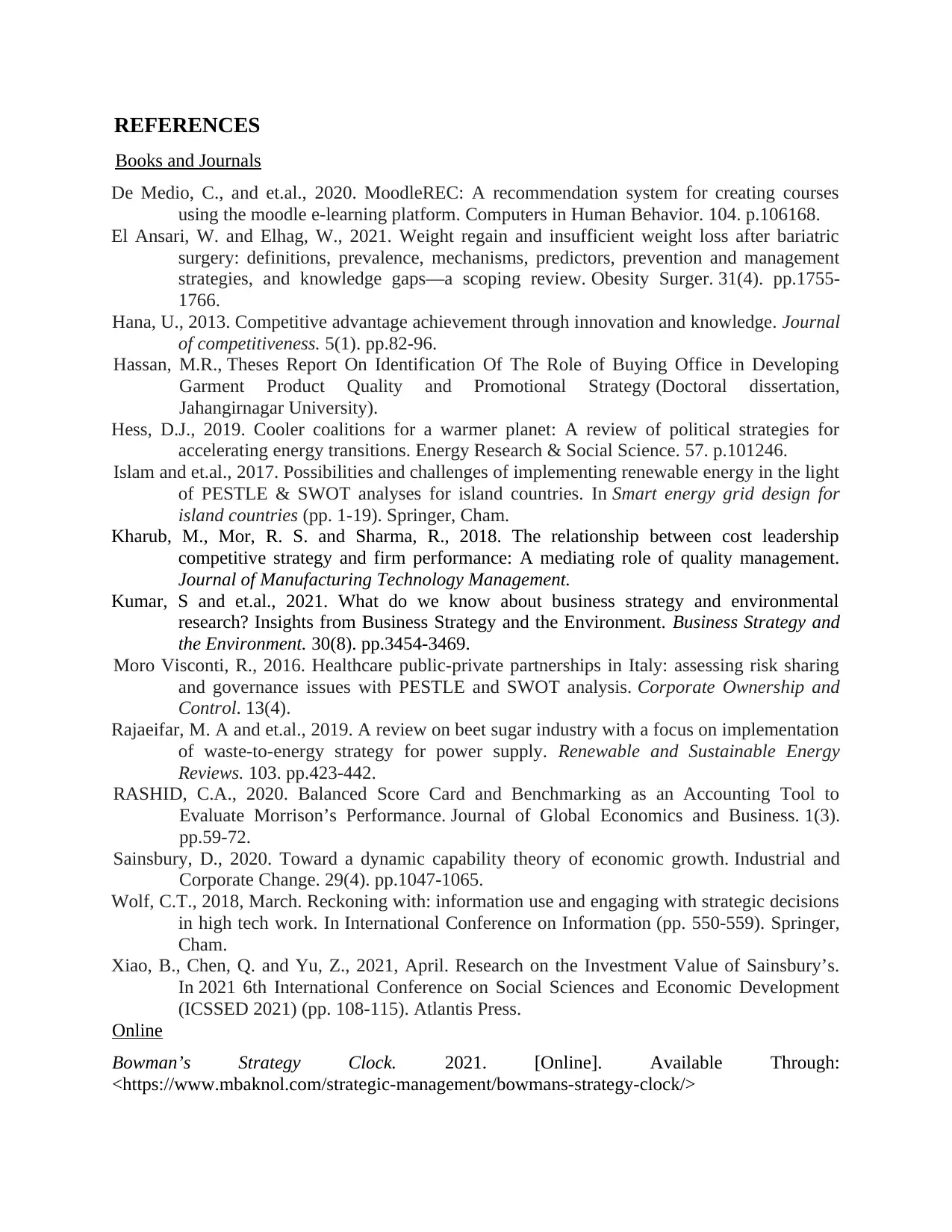
REFERENCES
Books and Journals
De Medio, C., and et.al., 2020. MoodleREC: A recommendation system for creating courses
using the moodle e-learning platform. Computers in Human Behavior. 104. p.106168.
El Ansari, W. and Elhag, W., 2021. Weight regain and insufficient weight loss after bariatric
surgery: definitions, prevalence, mechanisms, predictors, prevention and management
strategies, and knowledge gaps—a scoping review. Obesity Surger. 31(4). pp.1755-
1766.
Hana, U., 2013. Competitive advantage achievement through innovation and knowledge. Journal
of competitiveness. 5(1). pp.82-96.
Hassan, M.R., Theses Report On Identification Of The Role of Buying Office in Developing
Garment Product Quality and Promotional Strategy (Doctoral dissertation,
Jahangirnagar University).
Hess, D.J., 2019. Cooler coalitions for a warmer planet: A review of political strategies for
accelerating energy transitions. Energy Research & Social Science. 57. p.101246.
Islam and et.al., 2017. Possibilities and challenges of implementing renewable energy in the light
of PESTLE & SWOT analyses for island countries. In Smart energy grid design for
island countries (pp. 1-19). Springer, Cham.
Kharub, M., Mor, R. S. and Sharma, R., 2018. The relationship between cost leadership
competitive strategy and firm performance: A mediating role of quality management.
Journal of Manufacturing Technology Management.
Kumar, S and et.al., 2021. What do we know about business strategy and environmental
research? Insights from Business Strategy and the Environment. Business Strategy and
the Environment. 30(8). pp.3454-3469.
Moro Visconti, R., 2016. Healthcare public-private partnerships in Italy: assessing risk sharing
and governance issues with PESTLE and SWOT analysis. Corporate Ownership and
Control. 13(4).
Rajaeifar, M. A and et.al., 2019. A review on beet sugar industry with a focus on implementation
of waste-to-energy strategy for power supply. Renewable and Sustainable Energy
Reviews. 103. pp.423-442.
RASHID, C.A., 2020. Balanced Score Card and Benchmarking as an Accounting Tool to
Evaluate Morrison’s Performance. Journal of Global Economics and Business. 1(3).
pp.59-72.
Sainsbury, D., 2020. Toward a dynamic capability theory of economic growth. Industrial and
Corporate Change. 29(4). pp.1047-1065.
Wolf, C.T., 2018, March. Reckoning with: information use and engaging with strategic decisions
in high tech work. In International Conference on Information (pp. 550-559). Springer,
Cham.
Xiao, B., Chen, Q. and Yu, Z., 2021, April. Research on the Investment Value of Sainsbury’s.
In 2021 6th International Conference on Social Sciences and Economic Development
(ICSSED 2021) (pp. 108-115). Atlantis Press.
Online
Bowman’s Strategy Clock. 2021. [Online]. Available Through:
<https://www.mbaknol.com/strategic-management/bowmans-strategy-clock/>
Books and Journals
De Medio, C., and et.al., 2020. MoodleREC: A recommendation system for creating courses
using the moodle e-learning platform. Computers in Human Behavior. 104. p.106168.
El Ansari, W. and Elhag, W., 2021. Weight regain and insufficient weight loss after bariatric
surgery: definitions, prevalence, mechanisms, predictors, prevention and management
strategies, and knowledge gaps—a scoping review. Obesity Surger. 31(4). pp.1755-
1766.
Hana, U., 2013. Competitive advantage achievement through innovation and knowledge. Journal
of competitiveness. 5(1). pp.82-96.
Hassan, M.R., Theses Report On Identification Of The Role of Buying Office in Developing
Garment Product Quality and Promotional Strategy (Doctoral dissertation,
Jahangirnagar University).
Hess, D.J., 2019. Cooler coalitions for a warmer planet: A review of political strategies for
accelerating energy transitions. Energy Research & Social Science. 57. p.101246.
Islam and et.al., 2017. Possibilities and challenges of implementing renewable energy in the light
of PESTLE & SWOT analyses for island countries. In Smart energy grid design for
island countries (pp. 1-19). Springer, Cham.
Kharub, M., Mor, R. S. and Sharma, R., 2018. The relationship between cost leadership
competitive strategy and firm performance: A mediating role of quality management.
Journal of Manufacturing Technology Management.
Kumar, S and et.al., 2021. What do we know about business strategy and environmental
research? Insights from Business Strategy and the Environment. Business Strategy and
the Environment. 30(8). pp.3454-3469.
Moro Visconti, R., 2016. Healthcare public-private partnerships in Italy: assessing risk sharing
and governance issues with PESTLE and SWOT analysis. Corporate Ownership and
Control. 13(4).
Rajaeifar, M. A and et.al., 2019. A review on beet sugar industry with a focus on implementation
of waste-to-energy strategy for power supply. Renewable and Sustainable Energy
Reviews. 103. pp.423-442.
RASHID, C.A., 2020. Balanced Score Card and Benchmarking as an Accounting Tool to
Evaluate Morrison’s Performance. Journal of Global Economics and Business. 1(3).
pp.59-72.
Sainsbury, D., 2020. Toward a dynamic capability theory of economic growth. Industrial and
Corporate Change. 29(4). pp.1047-1065.
Wolf, C.T., 2018, March. Reckoning with: information use and engaging with strategic decisions
in high tech work. In International Conference on Information (pp. 550-559). Springer,
Cham.
Xiao, B., Chen, Q. and Yu, Z., 2021, April. Research on the Investment Value of Sainsbury’s.
In 2021 6th International Conference on Social Sciences and Economic Development
(ICSSED 2021) (pp. 108-115). Atlantis Press.
Online
Bowman’s Strategy Clock. 2021. [Online]. Available Through:
<https://www.mbaknol.com/strategic-management/bowmans-strategy-clock/>
1 out of 13
Related Documents
Your All-in-One AI-Powered Toolkit for Academic Success.
+13062052269
info@desklib.com
Available 24*7 on WhatsApp / Email
![[object Object]](/_next/static/media/star-bottom.7253800d.svg)
Unlock your academic potential
© 2024 | Zucol Services PVT LTD | All rights reserved.


